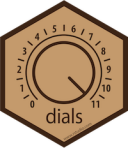glm_rec <-
recipe(on_goal ~ ., data = nhl_train) %>%
step_lencode_mixed(shooter, goaltender, outcome = vars(on_goal)) %>%
step_dummy(all_nominal_predictors()) %>%
step_mutate(
angle = abs( atan2(abs(coord_y), (89 - coord_x) ) * (180 / pi) ),
defensive_zone = ifelse(coord_x <= -25.5, 1, 0),
behind_goal_line = ifelse(coord_x >= 89, 1, 0)
) %>%
step_zv(all_predictors()) %>%
step_ns(angle, deg_free = tune("angle")) %>%
step_ns(coord_x, deg_free = tune("coord_x")) %>%
step_normalize(all_numeric_predictors())6 - Tuning Hyperparameters
Machine learning with tidymodels
Tuning parameters
Some model or preprocessing parameters cannot be estimated directly from the data.
Some examples:
- Tree depth in decision trees
- Number of neighbors in a K-nearest neighbor model
Activation function in neural networks?
Sigmoidal functions, ReLu, etc.
Yes, it is a tuning parameter. ✅
Number of PCA components to retain?
Yes, it is a tuning parameter. ✅
Bayesian priors for model parameters?
Hmmmm, probably not. These are based on prior belief. ❌
Covariance/correlation matrix structure in mixed models?
Yes, but it is unlikely to affect performance.
It will impact inference though. 🤔
Is the random seed a tuning parameter?
Nope. It is not. ❌
Optimize tuning parameters
- Try different values and measure their performance.
- Find good values for these parameters.
- Once the value(s) of the parameter(s) are determined, a model can be finalized by fitting the model to the entire training set.
Optimize tuning parameters
The main two strategies for optimization are:
Grid search 💠 which tests a pre-defined set of candidate values
Iterative search 🌀 which suggests/estimates new values of candidate parameters to evaluate
Choosing tuning parameters ![]()
![]()
![]()
![]()
Let’s take our previous recipe and add a few changes:
Let’s tune() our spline terms!
Choosing tuning parameters ![]()
![]()
![]()
![]()
Let’s take our previous recipe and add a few changes:
Splines and nonlinear relationships
Grid search
Parameters
The tidymodels framework provides pre-defined information on tuning parameters (such as their type, range, transformations, etc).
The
extract_parameter_set_dials()function extracts these tuning parameters and the info.
Grids
Create your grid manually or automatically.
The
grid_*()functions can make a grid.
Create a grid ![]()
![]()
A parameter set can be updated (e.g. to change the ranges).
Create a grid ![]()
![]()
- A space-filling design like this tends to perform better than random grids.
- Space-filling designs are also usually more efficient than regular grids.
Your turn

Create a grid for our tunable workflow.
Try creating a regular grid.
03:00
Create a grid ![]()
![]()
Update parameter ranges ![]()
![]()
set.seed(12)
grid <-
glm_spline_wflow %>%
extract_parameter_set_dials() %>%
update(angle = spline_degree(c(2L, 50L)),
coord_x = spline_degree(c(2L, 50L))) %>%
grid_latin_hypercube(size = 25)
grid
#> # A tibble: 25 × 2
#> angle coord_x
#> <int> <int>
#> 1 14 27
#> 2 4 42
#> 3 26 20
#> 4 36 16
#> 5 13 3
#> 6 20 33
#> 7 31 49
#> 8 40 44
#> 9 24 45
#> 10 34 18
#> # ℹ 15 more rowsThe results ![]()
![]()
Use the tune_*() functions to tune models
Spline grid search ![]()
![]()
![]()
set.seed(9)
ctrl <- control_grid(save_pred = TRUE, parallel_over = "everything")
glm_spline_res <-
glm_spline_wflow %>%
tune_grid(resamples = nhl_val, grid = grid, control = ctrl)
glm_spline_res
#> # Tuning results
#> # Validation Set Split (0.8/0.2)
#> # A tibble: 1 × 5
#> splits id .metrics .notes .predictions
#> <list> <chr> <list> <list> <list>
#> 1 <split [5348/1338]> validation <tibble [50 × 6]> <tibble [2 × 3]> <tibble [33,450 × 8]>
#>
#> There were issues with some computations:
#>
#> - Warning(s) x1: glm.fit: algorithm did not converge, glm.fit: fitted probabilities numerically 0 or 1 occurred
#> - Warning(s) x1: glm.fit: fitted probabilities numerically 0 or 1 occurred
#>
#> Run `show_notes(.Last.tune.result)` for more information.Your turn

Tune our glm_wflow.
What happens if you don’t supply a grid argument to tune_grid()?
05:00
Grid results ![]()
Tuning results ![]()
collect_metrics(glm_spline_res)
#> # A tibble: 50 × 8
#> angle coord_x .metric .estimator mean n std_err .config
#> <int> <int> <chr> <chr> <dbl> <int> <dbl> <chr>
#> 1 14 27 accuracy binary 0.804 1 NA Preprocessor01_Model1
#> 2 14 27 roc_auc binary 0.815 1 NA Preprocessor01_Model1
#> 3 4 42 accuracy binary 0.808 1 NA Preprocessor02_Model1
#> 4 4 42 roc_auc binary 0.820 1 NA Preprocessor02_Model1
#> 5 26 20 accuracy binary 0.805 1 NA Preprocessor03_Model1
#> 6 26 20 roc_auc binary 0.819 1 NA Preprocessor03_Model1
#> 7 36 16 accuracy binary 0.800 1 NA Preprocessor04_Model1
#> 8 36 16 roc_auc binary 0.817 1 NA Preprocessor04_Model1
#> 9 13 3 accuracy binary 0.803 1 NA Preprocessor05_Model1
#> 10 13 3 roc_auc binary 0.807 1 NA Preprocessor05_Model1
#> # ℹ 40 more rowsTuning results ![]()
collect_metrics(glm_spline_res, summarize = FALSE)
#> # A tibble: 50 × 7
#> id angle coord_x .metric .estimator .estimate .config
#> <chr> <int> <int> <chr> <chr> <dbl> <chr>
#> 1 validation 14 27 accuracy binary 0.804 Preprocessor01_Model1
#> 2 validation 14 27 roc_auc binary 0.815 Preprocessor01_Model1
#> 3 validation 4 42 accuracy binary 0.808 Preprocessor02_Model1
#> 4 validation 4 42 roc_auc binary 0.820 Preprocessor02_Model1
#> 5 validation 26 20 accuracy binary 0.805 Preprocessor03_Model1
#> 6 validation 26 20 roc_auc binary 0.819 Preprocessor03_Model1
#> 7 validation 36 16 accuracy binary 0.800 Preprocessor04_Model1
#> 8 validation 36 16 roc_auc binary 0.817 Preprocessor04_Model1
#> 9 validation 13 3 accuracy binary 0.803 Preprocessor05_Model1
#> 10 validation 13 3 roc_auc binary 0.807 Preprocessor05_Model1
#> # ℹ 40 more rowsChoose a parameter combination ![]()
show_best(glm_spline_res, metric = "roc_auc")
#> # A tibble: 5 × 8
#> angle coord_x .metric .estimator mean n std_err .config
#> <int> <int> <chr> <chr> <dbl> <int> <dbl> <chr>
#> 1 4 42 roc_auc binary 0.820 1 NA Preprocessor02_Model1
#> 2 26 20 roc_auc binary 0.819 1 NA Preprocessor03_Model1
#> 3 36 16 roc_auc binary 0.817 1 NA Preprocessor04_Model1
#> 4 40 44 roc_auc binary 0.817 1 NA Preprocessor08_Model1
#> 5 37 27 roc_auc binary 0.816 1 NA Preprocessor15_Model1Choose a parameter combination ![]()
Create your own tibble for final parameters or use one of the tune::select_*() functions:
This best result has:
- low-degree spline for
angle(less “wiggly”, less complex) - higher-degree spline for
coord_x(more “wiggly”, more complex)
Boosted trees 🌳🌲🌴🌵🌴🌳🌳🌴🌲🌵🌴🌲🌳🌴🌳🌵🌵🌴🌲🌲🌳🌴🌳🌴🌲🌴🌵🌴🌲🌴🌵🌲🌵🌴🌲🌳🌴🌵🌳🌴🌳
Boosted trees 🌳🌲🌴🌵🌳🌳🌴🌲🌵🌴🌳🌵
- Ensemble many decision tree models
Review how a decision tree model works:
Series of splits or if/then statements based on predictors
First the tree grows until some condition is met (maximum depth, no more data)
Then the tree is pruned to reduce its complexity
Single decision tree
Boosted trees 🌳🌲🌴🌵🌳🌳🌴🌲🌵🌴🌳🌵
Boosting methods fit a sequence of tree-based models.
Each tree is dependent on the one before and tries to compensate for any poor results in the previous trees.
This is like gradient-based steepest ascent methods from calculus.
Boosted tree tuning parameters
Most modern boosting methods have a lot of tuning parameters!
For tree growth and pruning (
min_n,max_depth, etc)For boosting (
trees,stop_iter,learn_rate)
We’ll use early stopping to stop boosting when a few iterations produce consecutively worse results.
Comparing tree ensembles
Random forest
- Independent trees
- Bootstrapped data
- No pruning
- 1000’s of trees
Boosting
- Dependent trees
- Different case weights
- Tune tree parameters
- Far fewer trees
The general consensus for tree-based models is, in terms of performance: boosting > random forest > bagging > single trees.
Boosted tree code
xgb_spec <-
boost_tree(
trees = tune(), min_n = tune(), tree_depth = tune(),
learn_rate = tune(), loss_reduction = tune()
) %>%
set_mode("classification") %>%
set_engine("xgboost")
xgb_rec <-
recipe(on_goal ~ ., data = nhl_train) %>%
step_lencode_mixed(shooter, goaltender, outcome = vars(on_goal)) %>%
step_dummy(all_nominal_predictors()) %>%
step_zv(all_predictors())
xgb_wflow <-
workflow() %>%
add_model(xgb_spec) %>%
add_recipe(xgb_rec)Your turn

Create your boosted tree workflow.
03:00
Running in parallel
Grid search, combined with resampling, requires fitting a lot of models!
These models don’t depend on one another and can be run in parallel.
We can use a parallel backend to do this:
Running in parallel
Speed-ups are fairly linear up to the number of physical cores (10 here).
Tuning ![]()
This will take some time to run ⏳
Your turn

Start tuning the boosted tree model!
We won’t wait for everyone’s tuning to finish, but take this time to get it started before we move on.
03:00
Tuning results ![]()
Tuning results ![]()
Again with the location features
coord_rec <-
xgb_rec %>%
step_mutate(
angle = abs( atan2(abs(coord_y), (89 - coord_x) ) * (180 / pi) ),
defensive_zone = ifelse(coord_x <= -25.5, 1, 0),
behind_goal_line = ifelse(coord_x >= 89, 1, 0)
)
xgb_coord_wflow <-
workflow() %>%
add_model(xgb_spec) %>%
add_recipe(coord_rec)
set.seed(9)
xgb_coord_res <-
xgb_coord_wflow %>%
tune_grid(resamples = nhl_val, grid = 30, control = ctrl)Did the machine figure it out?
No extra features:
show_best(xgb_res, metric = "roc_auc", n = 3)
#> # A tibble: 3 × 11
#> trees min_n tree_depth learn_rate loss_reduction .metric .estimator mean n std_err .config
#> <int> <int> <int> <dbl> <dbl> <chr> <chr> <dbl> <int> <dbl> <chr>
#> 1 1697 3 3 0.0116 0.674 roc_auc binary 0.804 1 NA Preprocessor1_Model02
#> 2 1264 16 2 0.00732 0.000340 roc_auc binary 0.803 1 NA Preprocessor1_Model12
#> 3 569 39 4 0.0272 0.0000288 roc_auc binary 0.800 1 NA Preprocessor1_Model30With additional coordinate features:
show_best(xgb_coord_res, metric = "roc_auc", n = 3)
#> # A tibble: 3 × 11
#> trees min_n tree_depth learn_rate loss_reduction .metric .estimator mean n std_err .config
#> <int> <int> <int> <dbl> <dbl> <chr> <chr> <dbl> <int> <dbl> <chr>
#> 1 1697 3 3 0.0116 0.674 roc_auc binary 0.807 1 NA Preprocessor1_Model02
#> 2 1264 16 2 0.00732 0.000340 roc_auc binary 0.804 1 NA Preprocessor1_Model12
#> 3 427 31 2 0.249 0.0000000773 roc_auc binary 0.803 1 NA Preprocessor1_Model23Compare models
Best logistic regression results:
Updating the workflow ![]()
![]()
best_auc <- select_best(glm_spline_res, metric = "roc_auc")
best_auc
#> # A tibble: 1 × 3
#> angle coord_x .config
#> <int> <int> <chr>
#> 1 4 42 Preprocessor02_Model1
glm_spline_wflow <-
glm_spline_wflow %>%
finalize_workflow(best_auc)
glm_spline_wflow
#> ══ Workflow ══════════════════════════════════════════════════════════
#> Preprocessor: Recipe
#> Model: logistic_reg()
#>
#> ── Preprocessor ──────────────────────────────────────────────────────
#> 7 Recipe Steps
#>
#> • step_lencode_mixed()
#> • step_dummy()
#> • step_mutate()
#> • step_zv()
#> • step_ns()
#> • step_ns()
#> • step_normalize()
#>
#> ── Model ─────────────────────────────────────────────────────────────
#> Logistic Regression Model Specification (classification)
#>
#> Computational engine: glmThe final fit to the NHL data ![]()
![]()
test_res <-
glm_spline_wflow %>%
last_fit(split = nhl_split)
test_res
#> # Resampling results
#> # Manual resampling
#> # A tibble: 1 × 6
#> splits id .metrics .notes .predictions .workflow
#> <list> <chr> <list> <list> <list> <list>
#> 1 <split [6686/2229]> train/test split <tibble [2 × 4]> <tibble [0 × 3]> <tibble [2,229 × 6]> <workflow>Remember that last_fit() fits one time with the combined training and validation set, then evaluates one time with the testing set.
Your turn

Finalize your workflow with the best parameters.
Create a final fit.
08:00
Estimates of ROC AUC ![]()
Validation results from tuning:
Final fitted workflow
Extract the final fitted workflow, fit using the training set:
Next steps
- Create an applicability domain model to help monitor our data over time.
- Use explainers to characterize the model and the predictions.
Explain yourself
There are two categories of model explanations, global and local.
Global model explanations provide an overall understanding aggregated over a whole set of observations.
Local model explanations provide information about a prediction for a single observation.
You can also build global model explanations by aggregating local model explanations.
tidymodels integrates with model explainability frameworks

A tidymodels explainer
We can build explainers using:
- original, basic predictors
- derived features
Explain the x coordinates
With our explainer, let’s create partial dependence profiles:
You can use the default plot() method or create your own visualization.
Explain the x coordinates
Explain the x coordinates
Your turn

Create an explainer for our glm model.
Try using other variables, like extra_attacker or game_seconds.
05:00




